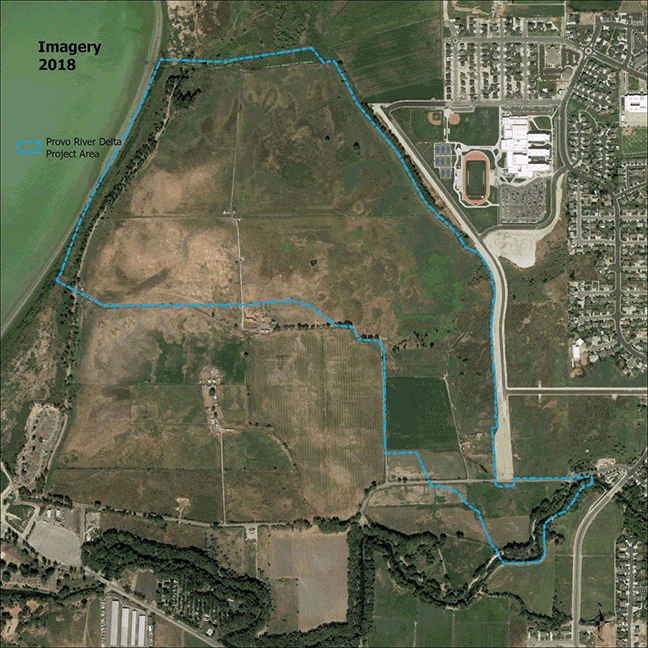Provo River Delta Restoration Project
2023 A Year In Review
View of Provo River Delta (Nov. 2023) looking south with Provo Bay in background. © Utah By Air
A River Ran To It
Photo of the first wave of Provo River water entering the new Provo River Delta on March 2, 2023.
Timelapse aerial footage of Provo River Delta project area from 2018 to 2023
2023 was a transformational year for Provo River Delta. On March 2, 2023, the project reached a major milestone — the Provo River was diverted into the channels and ponds constructed over the past three years, connecting the river with a restored delta and with Utah Lake. An enthusiastic crowd of over 200 local community members, government officials, project staff, educators and volunteers gathered to celebrate and watch excavators remove the final scoops of dirt needed to connect river with delta.
Although construction work continues, the “River Runs To It” event marked the completion of the project’s major aquatic habitat features. The area that had been hay fields and pasture prior to 2020 when construction began has now been transformed into a restored bay of Utah Lake.
New Delta Handles High Flows
2023’s record snowpack translated into high flows that tested the flood protection levees on the Provo River upstream of the Delta Project. Within the new Delta, natural flood mitigation is built into the project’s design. Because the connected channels, floodplains, and ponds are designed to overtop and spread out during high flows, they help dissipate flood energy and reduce the rate at which water levels rise. High flows are part of a natural ecosystem, so flooding is good for the biodiversity of the area as well.
In 2023, the delta performed just as designed. High flows overtopped the banks, connected to restored floodplain areas, deposited woody debris helpful for habitat complexity, and jump-started the growth of riparian plants like willows and cottonwoods. Despite the fact that the riverine section of the delta had not yet had time for vegetation to grow, only one section of streambank experienced erosion significant enough to warrant repair. This success was thanks to the crews that worked hard to install biodegradable coconut fiber bank protection blocks and blankets that helped protect delta soils and young plants. Bureau of Reclamation crews also did an amazing job of mobilizing to place fill and rock protection along the berms and banks of the confined river section of near Lakeview Parkway in advance of high flows.
Crews install biodegradable blankets to protect delta soils as high flows lap at the river's banks.
We Built it and They Came
Prior to diverting the Provo River into the new delta, some people wondered whether June sucker would be able to find the river’s new outlets and swim up the river to spawn. Monitoring results by Utah Division of Wildlife Resources fisheries biologists provided the answer: a resounding YES! More than 6,300 unique individual fish were detected entering the Delta and moving upstream during 2023’s spring spawning period. Because only a small portion of the June sucker population can be detected with netting and fish tracking antennas, the total number that entered the Delta during 2023 is likely 5 to 10 times greater. Later in the year, biologists also detected June sucker larvae and juveniles utilizing the restored Delta’s protective nursery habitat. These results are an encouraging sign for the ongoing recovery of the threatened June sucker.
June sucker biologists download detection data from one of the antennae deployed to track spawning activity in the new Delta.
New Focus on Original Channel
2023 marked the beginning of significant construction efforts on the original Provo River channel below the diversion structure. One of the summer’s big accomplishments was getting aeration systems up and running in the area between Lakeview Parkway and Lakeside RV campground. Pilot-testing results showed the systems improved dissolved oxygen conditions, helping protect water quality after most of the Provo River’s flow was diverted into the new delta. Crews also worked to maintain temporary flow delivery pipes to consistently deliver the minimum flow commitment of 10 cfs to the original channel.
One of two new buildings installed to house original channel aeration systems.
Another 2023 accomplishment was “downsizing” the upstream portion of the original channel between the diversion and Lakeview Parkway. This work was done to improve habitat and aesthetics and better match a reduced flow regime. Towards the end of 2023, construction crews also made major strides installing the permanent diversion structure. Specifically, concrete work on pipe inlets/ outlets was completed and trenching for the permanent pipe system was underway as of late December.
High spring runoff flows from 2023's record snowpack overtopping the streambank.
Juvenile June sucker were documented in the new Provo River Delta. Photo by Utah Division of Wildlife Resources
Bubbles from aeration diffuser. Photo by Bruce Pope
Newly poured concrete at diversion structure.
An excavator creates a point bar as part of original channel downsizing work.
2023 Outreach By the Numbers
Our 2nd Saturday delta site tours and community stewardship events have set new participation marks every year since we first started them in April 2021. 2023 was no exception. Busy as bees and beavers, 447 volunteers put in 656 hours this year, weeding, seeding, planting willows and picking up truckloads of litter washed down by high flows. Well over 500 people got a sneak peek at the new delta during our 27 guided tours. We also introduced 1,367 students and locals to Utah’s unique June sucker at 20 tabling and outreach events.
Willows and Rushes and Sedges, Oh My!
2023 saw the most ambitious Provo Delta revegetation effort to date. In November, about 100,000 native plants - mostly various rush, sedge, and willow species - were planted along the delta’s channels, ponds, and islands. The 2023 effort supplements the 150,000 plantings previously installed in the project area between 2020-2022. The ramp-up in planting numbers during 2023 was possible because the project is now hydrologically connected to the river and lake and the new plantings now have easy access to the water they need to thrive. In prior years, we had to install and maintain extensive temporary sprinkler irrigation systems to keep plants alive.
In 2023, the Utah Division of Wildlife Resources also seeded approximately 35 acres of habitat impacted by construction. The seed mix included 33 different species of native plants, including a variety of native wildflowers like beeplant, milkweed, and flax. The major revegetation feat accomplished by our work crews and volunteers could only be outdone by Mother Nature herself. Thousands of free cottonwoods and willows popped up in the delta’s floodplain after spring’s high flows receded. Thousands of other “free” plants have also sprouted up from the project area’s native seedbank now that the hydrology of this historic bay of Utah Lake has been reconnected.
Native plants thriving at Provo River Delta.
Looking Ahead to 2024
Are you excited? We’re excited! We have a ton of work ahead but are planning to open Provo River Delta to the public before the year ends. We hope to celebrate with a Grand Opening celebration - keep checking our website for a “Save the Date” notice and plan to attend!
In 2024, work efforts will include:
· Finishing the diversion structure
· Completing pre-loading of the small downstream dam to stabilize its foundation area
· Building the wildlife viewing tower
· Constructing Delta Gateway Park
· Completing construction of Skipper Bay trailhead and amenities
· Finishing and paving equestrian and paved trails
· Expanding the original channel aeration system
· Installing fishing platforms and non-motorized boat ramps on the original channel
















